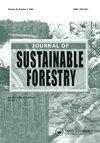预测南美西北部的野火危险
IF 1.8
4区 农林科学
Q3 FORESTRY
引用次数: 0
摘要
火灾危险通常被映射为火灾特征发生的静态条件概率。我们开发了一个动态产品,用于操作风险管理,以预测在当地可能的接近最大火灾强度范围内发生火灾辐射功率的概率。我们将标准的机器学习技术应用于遥感数据。我们使用块极大值方法对2001年至2020年南美西北部每个火灾季节自由燃烧燃料的最极端火灾辐射功率(FRP) MODIS检索结果以及相关的天气、燃料和地形特征进行了采样。我们使用随机森林算法进行分类和回归,实现向后逐步抑制过程。我们解决了预测近最大野火强度发生概率的分类问题,在运行时间序列交叉验证的10个年度测试集中,75%的召回率超出样本,在20次交叉验证中,77%的召回率和85%的ROC-AUC超出样本,以衡量生产中模型性能的现实预期。我们在样本内用86% r2解决了预测FRP的回归问题,但样本外的表现令人不满意。我们的模型很好地预测了秘鲁和哥伦比亚在山区和单峰火灾情况下报告的致命和接近致命事件,在双峰火灾情况下信号衰减。本文章由计算机程序翻译,如有差异,请以英文原文为准。
Forecasting wildfire hazard across northwestern south America
Fire hazard is often mapped as a static conditional probability of fire characteristics’ occurrence. We developed a dynamic product for operational risk management to forecast the probability of occurrence of fire radiative power in the locally possible near-maximum fire intensity range. We applied standard machine learning techniques to remotely sensed data. We used a block maxima approach to sample the most extreme fire radiative power (FRP) MODIS retrievals in free-burning fuels for each fire season between 2001 and 2020 and associated weather, fuel, and topography features in northwestern south America. We used the random forest algorithm for both classification and regression, implementing the backward stepwise repression procedure. We solved the classification problem predicting the probability of occurrence of near-maximum wildfire intensity with 75% recall out-of-sample in ten annual test sets running time series cross validation, and 77% recall and 85% ROC-AUC out-of-sample in a twenty-fold cross-validation to gauge a realistic expectation of model performance in production. We solved the regression problem predicting FRP with 86% r2 in-sample, but out-of-sample performance was unsatisfactory. Our model predicts well fatal and near-fatal incidents reported in Peru and Colombia out-of-sample in mountainous areas and unimodal fire regimes, the signal decays in bimodal fire regimes.
求助全文
通过发布文献求助,成功后即可免费获取论文全文。
去求助
来源期刊

Journal of Sustainable Forestry
Social Sciences-Geography, Planning and Development
CiteScore
3.90
自引率
12.50%
发文量
42
期刊介绍:
Journal of Sustainable Forestry publishes peer-reviewed, original research on forest science. While the emphasis is on sustainable use of forest products and services, the journal covers a wide range of topics from the underlying biology and ecology of forests to the social, economic and policy aspects of forestry. Short communications and review papers that provide a clear theoretical, conceptual or methodological contribution to the existing literature are also included in the journal.
Common topics covered in the Journal of Sustainable Forestry include:
• Ecology, management, recreation, restoration and silvicultural systems of all forest types, including urban forests
• All aspects of forest biology, including ecophysiology, entomology, pathology, genetics, tree breeding, and biotechnology
• Wood properties, forest biomass, bioenergy, and carbon sequestration
• Simulation modeling, inventory, quantitative methods, and remote sensing
• Environmental pollution, fire and climate change impacts, and adaptation and mitigation in forests
• Forest engineering, economics, human dimensions, natural resource policy, and planning
Journal of Sustainable Forestry provides an international forum for dialogue between research scientists, forest managers, economists and policy and decision makers who share the common vision of the sustainable use of natural resources.
 求助内容:
求助内容: 应助结果提醒方式:
应助结果提醒方式:


